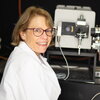
Contact Information
University of Illinois
127 RAL, Box C-3
600 South Mathews Avenue
Urbana, IL 61801
Research Interests
nanomechanics of biomolecules, cell adhesion, biomaterials, tissue engineering; structure/function relationships of cell adhesion proteins and their role in disease; single-molecule biophysics; mechanistic studies of protein recognition and bio-adhesion; allosteric regulation of protein functions; molecular tension sensors in biology; molecular basis of biological recognition and bio-adhesion; single molecule techniques; molecular force probes; molecular dynamics simulations and measurements of single cell interactions
Research Description
Research in the Biosurfaces Laboratory is at the interface between biology and surface science. Surfaces are ubiquitous in biology, and biological reactions at interfaces are central to a range of issues in medicine, biotechnology, and basic cell biology. For example, coatings on drug carriers increase blood circulation times and target blood borne delivery vehicles to specific tissues. Bio-recognition or enzymatic reactions at device surfaces are the basis of biosensors and microarrays. Nonspecific protein adsorption fouls contact lenses, implants, biosensors, and even ship hulls. In vivo, cell adhesion is essential for embryogenesis, wound healing, immunity, and a host of critical biological processes.
Our research is determining how the physical chemical properties of surfaces impacts fundamental biological functions and device/material performance in biological environments. We use state-of-the-art approaches to control surface chemistry, material properties, and the spatio-temporal distribution of cell stimuli. Biophysical measurements together with protein engineering and cell biology techniques determine how cells communicate with and respond to their environment. To address these issues, we are organized along two, closely coupled research themes.
The Biological Interfaces Group uses surface modification, micro-patterning, and materials synthesis to precisely manipulate cell microenvironments. These powerful tools control concentration profiles of soluble factors and adhesive cues. We also tune mechanical properties of scaffolds to mimic in vivo tissue environments, and thereby precisely control cell stimuli in ways that are difficult to achieve in vivo. Through collaborations with biologists both at UIUC and other institutions, we use these platforms to understand and manipulate cell behavior. Current projects (i) identify design rules for controlling material properties in aqueous/biological environments, (ii) determine how engineered adhesive and soluble cues direct stem cell differentiation, (ii) identify how the interplay between different adhesion receptors controls cell adhesion and migration in cancer metastasis, wound healing, and embryonic development.
Research achievements include identifying the molecular design criteria for drug delivery coatings and non-fouling contact lens materials. We similarly established design rules for "smart" coatings that change interfacial properties in response to a pH or temperature switch.
The Cell Adhesion Biophysics Group addresses fundamental mechanisms of cell adhesion (to other cells or biomaterials) and the transduction of mechano-chemical signals across cell membranes. We use a multi-scale approach to determine how the structures of protein nanomachines govern the organization and mechanical properties of cells in tissues. Simulations identify how protein bonds rupture under force (as in cell migration) and the key force-bearing amino acids in receptor-ligand bonds. Single molecule and surface force measurements test theoretical predictions and quantify the strengths and kinetics of biomolecular bonds. Adhesion measurements between single cells further translate the nanomechanical properties of protein linkages to the assembly of cell junctions in tissues. More recent work uses complementary mechanical and biochemical approaches to determine how adhesion proteins transduce signals across cell membranes to regulate cell function, cell migration, and the elasticity of normal and diseased tissues.
Highlights of the Adhesion Biophysics Group include determining how the presentation of carbohydrate binding sites in lectins impacts pathogen recognition in innate immunity. They also discovered novel mechanisms by which adhesion molecules zip up cell-cell junctions in tissues.
In summary, this research program uses novel tools to determine how cells communicate with their environment. The synergistic activities of the Biological Interfaces and Cell Adhesion Biophysics teams generate an exciting, dynamic, and highly interdisciplinary research environment. This is an ideal environment for individuals who seek novel, cross-disciplinary problems with direct implications for biotechnology and human health.
Education
B.S., Humboldt State University, 1982
Ph.D., Cornell University, 1988
Postdoctorate, Massachusetts Institute of Technology and University of California, Santa Barbara, 1988-1992
Awards and Honors
Fellow, Biomedical Engineering Society (BMES), 2014
Fellow, American Chemical Society, 2009
Reid T. Milner Professor, University of Illinois, UC, 2006-
Fellow, American Association for the Advancement of Science, 2005
Fellow, American Institute for Medical and Biological Engineering, 2005
James W. Westwater Professor, University of Illinois, UC, 2004-2006
Britton Chance Distinguished Lecturer, University of Pennsylvania, 2004
Additional Campus Affiliations
Affiliate Professor, Biochemistry
External Links
Recent Publications
Vu, V., Sullivan, B., Hebner, E., Rahil, Z., Zou, Y., & Leckband, D. (2025). Cadherins and growth factor receptors – ligand-selective mechano-switches at cadherin junctions. Journal of cell science, 138(3), Article jcs262279. https://doi.org/10.1242/jcs.262279
Zou, Y., Allen, N., Rauf, E., & Leckband, D. (2025). Epidermal growth factor receptor is an essential component in E-cadherin force transduction complexes. Journal of cell science, 138(21), Article jcs264350. https://doi.org/10.1242/jcs.264350
Leckband, D., Schwartz, D. K., & Wu, Y. (2024). Computational and experimental approaches to quantify protein binding interactions under confinement. Biophysical journal, 123(4), 424-434. https://doi.org/10.1016/j.bpj.2024.01.018
Leckband, D., & Mofrad, M. R. K. (2024). Editorial overview: Biomechanics and mechanobiology: Mechano-genomics. Current Opinion in Biomedical Engineering, 31, Article 100536. https://doi.org/10.1016/j.cobme.2024.100536
Chang, R., Gruebele, M., & Leckband, D. E. (2023). Protein Folding Stability and Kinetics in Alginate Hydrogels. Biomacromolecules, 24(11), 5245-5254. https://doi.org/10.1021/acs.biomac.3c00764
